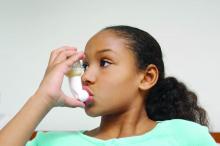DALLAS – Allowing public and private schools to store multiuse stock albuterol inhalers for students with asthma is a legally and medically feasible way to provide students with rescue medication without their need to leave school, according to a recent study.
“Stakeholder coalitions can facilitate the large-scale adoption of stock inhaler programs in schools,” concluded Ashley A. Lowe, MSPH, a senior research specialist and PhD candidate at the University of Arizona, Tucson, and colleagues in a poster at the American Thoracic Society’s international conference.“These programs improve access to rescue medication while returning students back to their classroom.”
The Arizona legislature passed H.B. 2208, “Stock Inhalers for Schools” in March 2017 to allow schools to store and administer albuterol sulfate while indemnifying trained staff against liability when they allowed students to use the inhaler in good faith. A stock inhaler can used by different students because of its disposable valved-holding chambers.
“Such laws allow schools to overcome the legal obstacles that make it difficult for them to ensure such medication is readily available to all children experiencing respiratory distress,” the authors wrote. They assessed the use and outcomes of schools’ storage of stock inhalers during the 2017-2018 school year in Pima County, Arizona.
Of the 213 public, 90 charter, and 61 private/parochial schools in Pima County, 246 (67%) total schools participated, including nearly all of the public schools (93%), nearly half the private/parochial schools (49%), and 17% of the charter schools. A total of 134,251 students had access to a stock inhaler at school.
Each participating school received a kit containing a 60-dose albuterol sulfate inhaler, 10 valved-holding chambers, a signed standing medical order, a standardized emergency protocol for albuterol use, access to an online training curriculum and template resources, along with technical support.
Each time a school used the stock inhaler, they documented whether an asthma diagnosis was known or not, total puffs administered and where the student went next – returned to class, sent home with caregiver, 911 call without transport, or 911 call with EMS transport.
Based on data analyzed from 240 schools, the stock inhalers were used 1,032 times at 152 schools during the study period, predominantly at public schools (97%) and by students with a known asthma diagnosis (82%). In 12.2% of cases, the student did not have a known asthma diagnosis, and 5.8% of the time, asthma diagnosis status was unknown. The students received a mean 2.7 puffs at each use.
Ethnicity and race data of those students who used the inhalers was not complete. Most of the students for whom ethnicity data were available (n = 343) and who used the inhaler were Hispanic/Latino (69.8%) independent of race. Based only on the 437 students for whom data on race were available, students using the inhaler included 41% white, 11.7% black, 3.1% Native American/Alaskan Native, 1% Asian and 0.6% Native Hawaiian/Pacific Islander.
Among the 915 uses of the inhaler for which subsequent student location was available, the majority of students (84%) returned to their classroom after using the inhaler. Only five were transported to a medical facility via EMS following a 911 call, and 911 was called for one student who did not receive EMS transport.
According to the Allergy & Asthma Network, the following states have school stock albuterol laws: Arizona, Colorado, Georgia, Illinois, Missouri, New Hampshire, New Mexico, Oklahoma, Ohio, Texas, Utah, and West Virginia.*
The research was funded by Banner–University Medical Center Tucson, Thayer Medical Corporation, and the Asthma & Airway Disease Research Center. The authors had no disclosures.
SOURCE: Lowe AA et al. ATS 2019, Abstract A4070.
* This article was updated on July 15, 2019.


